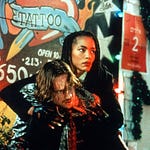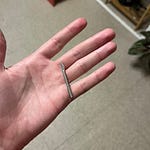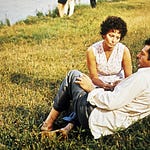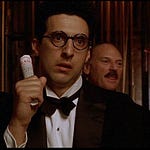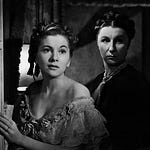A beautiful young man strolls through a field of white flowers—perhaps one of the many clearings to be found in San Francisco’s byzantine Golden Gate Park. Our beauty encounters another beauty, though this one is nowhere near as beautiful as our original, a truth we gather less by comparison than by the composition of the shots; the actors’ wardrobes; and the way the camera follows the slow, almost contemplative movements of our anointed one. As the other watches, the beautiful young man undoes his skintight leathers to stroke and climax from among the fallen white flowers, surrounded by the violins of what’s known colloquially as Pachelbel’s Canon.
When Peter Berlin’s That Boy was filmed in the early seventies, Johann Pachelbel’s “Canon in D Major” had not yet become the anthem of weddings and college graduations. Sweet yet plodding, its growing popularity since the 1980s has turned the canon into the West’s aural shorthand for major life events that are serious but rote, sentimental yet unfeeling, normal and yet far from natural. One may suspect that the bridal tenderness the music imbues That Boy is an intentional juxtaposition with its hardcore gay sex, arthouse plotlessness, and leatherfuck1 finale2, but I like to think otherwise.
Philosophical, romantic, imaginative, comical (though whether that’s intentional is also unclear3), and ultimately transcendent, That Boy encapsulates the mythos of Berlin, legendary muse of Mapplethorpe and Warhol and pre-internet “photosexual” whose documentation of his own beauty “gave a world starved of blatantly gay visual role models a new conception of the beautiful, empowered, self-loving, sensual, shameless gay man.” As his alter-ego, Helmut, Berlin struts Lou Sullivan’s Polk Street (now gentrified into oblivion), where he is observed by all with the fascinated adoration of his park cruise. In art as in life, Berlin is his own fantasy, too4: “Every guy I meet is in competition with myself. I get into my persona. I look at myself; I have sex with myself.”
As art, and particularly as pornographic art, That Boy collapses fantasy with the stylization of a real man’s life that is and remains, by all reports, utterly dedicated to cruising. While he has called the camera his “dream lover,” Berlin’s artistry does not, cannot, supplant the reality of his body among other bodies. “Real for me,” he told Aperture a few years ago, “is when I walk the streets and you pass me, I look at you, you look at me, we pass each other, and then I look back, and you look back, and you stop. That’s real! That will never happen inside a computer.”
Find me on Twitter. Get my second novel, X, right here.
I don’t want to fail to acknowledge that a few explicit Nazi symbols appear in That Boy, much of it on the leather regalia of the final scene. While Berlin’s provenance—he was born to a well-off German family in Nazi-occupied Poland in 1942—is not immaterial here, military, police, uniform, fascist, and, indeed, Nazi symbolism have never been uncharacteristic of leather subcultures in the USA. I’ve written toward these connections before, but I’m far from any kind of authority on them.
Contrast it, too, against the UX of whatever porn aggregator where you view it. (I don’t recommend using those, but I’m not going to pretend it isn’t available there!)
“There's a comic tinge to his eroticism,” writes Armistead Maupin. “[H]e's too preposterously doll-like to exist. I think of him as the Bettie Page of beefcake.”





